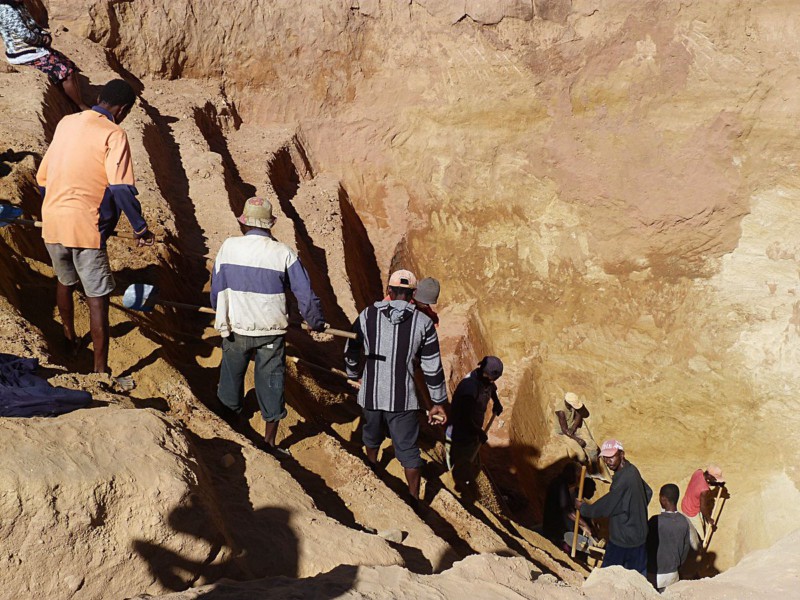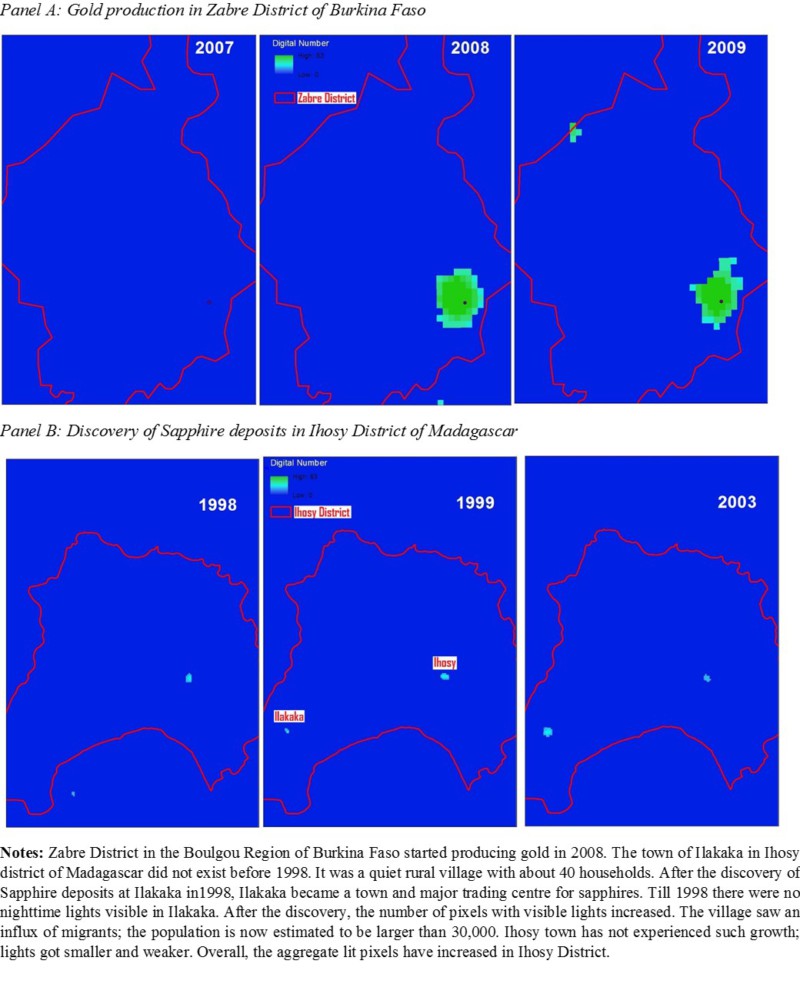By Sambit Bhattacharyya, Nemera Mamo, Alexander Moradi – University of Sussex
Living standards appear to have improved in Sub-Saharan Africa over the last two decades, mainly riding on the back of relatively high global commodity prices. For example, Figure 2 panels A and B below reveal that mineral extraction and mineral discovery lead to significant improvements in economic activity measured by night-time lights. Panel A zooms into Zabre District in the Boulgou Region of Burkina Faso. Zabre has produced her first mineral commodity, gold, in 2008. The change in the economic fortunes of Zabre is visually apparent here via the satellite images of night-time lights before and after gold production. In 2007 before gold production, the mean pixel value of night-time lights in Zabre is 0.00577. But, in 2008, the mean pixel value increased to 0.3056. The following year, 2009, Zabre again experienced an increase in night-time lights. So much for night-time lights, what about population? In 2007, the Socioeconomic Data and Applications Centre estimates Zabre’s population to be 135,582 and the population five years later in 2012 is estimated to be 160,150. Again, an 18 percent increase. Panel B reveals a similar story before and after the discovery of a Sapphire mine in 1998 in the town of Ilakaka in the Ihosy district of Madagascar. The town Ilakaka did not exist before 1998.
These positive case studies notwithstanding, very little is known about their durability and potential spillovers to other districts. In a recent CSAE working paper, Mamo et al. (2017) examines the effect of mining on development in Sub-Saharan Africa at different levels of spatial stratification. In particular, they analyse the effect of mining expansion at the intensive (production expansion in existing mines) and extensive (new production and discovery) margins on development measured by nightlights. Using spatial econometrics and GIS, they also analyse the extent of spillovers from a mine.
They find that mineral production and mineral discovery significantly improve living standards at the district level in 42 sub-Saharan African countries over the period 1992 to 2012. Night-lights increase due to mining expansion at the intensive margin. However, the effects are large at the extensive margin following new production and new discoveries. In particular, night-lights expand by 55 percent on average due to mining expansion at the extensive margin as opposed to 2-4 percent at the intensive margin. They observe that the positive influence of mineral production takes effect approximately two years prior to the actual start of mineral production. This is consistent with the view that installation of mining infrastructure and worker arrival typically predates production.
In order to precisely identify the effect of mining on development, Mamo et al. (2017) exploit the exogenous variation in the discovery dates of giant and major deposits of 21 minerals. They find that the positive effect of discovery on night-time lights enter approximately six years after the first discovery. The magnitude of the effect of first discovery is 19 percent on the sixth year and continues to rise to 44 percent on the tenth year.
Mining of exhaustible resources is often transitory. Therefore, an important question is to ascertain what happens in mining districts after mine closure. They find that night-time lights after mine closure decline precipitously undoing most of the gains.
Economic development is a general equilibrium phenomenon. Therefore, analysing the extent of linkages from mines is crucial. For instance, focusing on the subnational district level data might mask the fact that mining districts gain at the expense of non-mining districts. In order to unmask such patterns, Mamo et al. (2017) estimate a spatial model. They also test the model at the level of regions and whether the economies of the capital city and the largest cities respond to mining. They do not find evidence of spillover beyond the host district.
The results attest to the theoretical ideas of an earlier literature that that mining in a developing country is typically an ‘enclave’ (Singer, 1950; Murphy et al., 1989). The lack of spillover indicates that there is very little backward and forward linkages associated with mining.
Figure 1: open cast mine, Ilakaka, Madagascar (creative commons: Wayne77)

Figure 2: Mining Production, Mining Discovery and Nightlights

References:
Mamo, N., S. Bhattacharyya, A. Moradi and R. Arezki (2017), “Intensive and Extensive Margins of Mining and Development: Evidence from Sub-Saharan Africa.” CSAE Working Paper Number WPS/2017-05, University of Oxford.
Murphy, Kevin M, Andrei Shleifer, and Robert W Vishny (1989), “Industrialization and the Big Push.” Journal of Political Economy, 97, 1003–1026.
Singer, H. W. (1950), “The Distribution of Gains between Investing and Borrowing Countries.” The American Economic Review, 40, 473–485.
